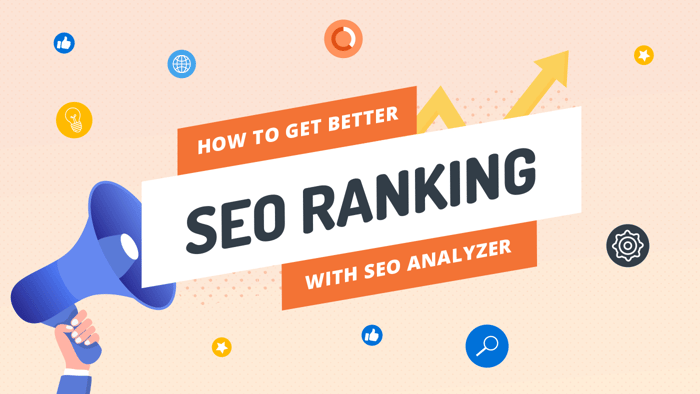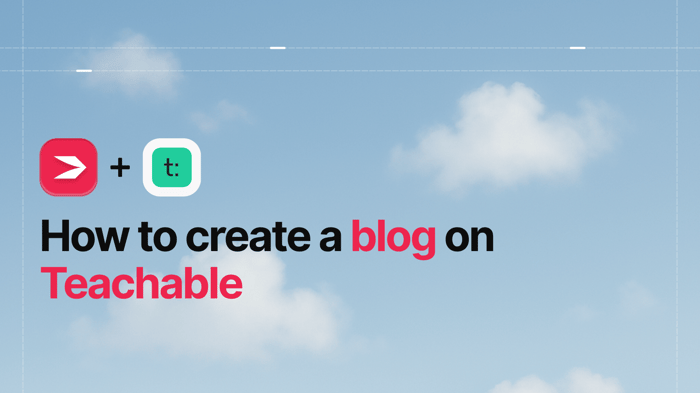Teachable and Udemy offer many possibilities to people who want to turn their knowledge and passion for teaching into a profitable business. If you’re considering creating an online course or migrating from one web platform to another, you might’ve been wondering if one of these two would be right for you.
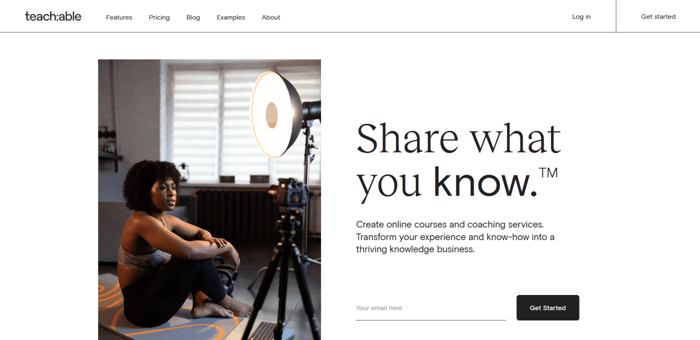
If that’s the case, this Teachable vs. Udemy comparison will detail the best bits and the worst bits of each platform and potentially help you choose between these platforms.
In this article, we’ll single out three upsides and three downsides of each platform and leave it to you to determine which one – Teachable or Udemy – would work better for you.
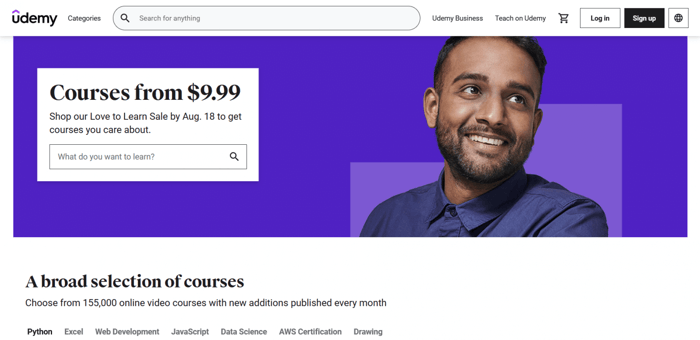
| Udemy | |
| Pros | Cons |
|
|
| Teachable | |
| Pros | Cons |
|
|
Table of Contents
Why Is Udemy Good?
1. Udemy Takes Care of Everything
Udemy is an enormous marketplace. It’s like Etsy or even Amazon for online learning. Currently, there are over 200,000 courses on the platform and probably many thousands of instructors and educators.
The platform receives over 100 million monthly visits, and when you sign up for an instructor account, you “inherit” a community of over 50 million students. You don’t need to build your audience from scratch because Udemy takes care of all the marketing for you. You just need to create and publish your course on the platform, and Udemy will make sure that potential customers see what you’ve got to offer. It all saves you a lot of time, money, and energy.
In addition, the sign-up process is very simple, and there’s so little to set up compared to Teachable and other course-creation platforms. You just need to connect your PayPal, Payoneer, or bank account (for U.S. residents) to receive payments. Then you leave an email address, fill out some basic information, and you’re all done.
You can virtually start selling your courses right then and there. There are no complex configuration processes, no editors (not even drag-and-drop), no coding, no features that you can’t get your head around, no worrying about domains and hosting – in short, on Udemy, everything is super simplified.
Of course, it goes without saying that you’ll have to build a name for yourself on the platform so that users will choose your courses. Nevertheless, not starting from scratch is a pretty good way to start your journey as an online instructor.
Basic Analytics Included
Besides this, Udemy gives you an insight into statistics related to your courses like:
- Revenue
- Students and enrollments
- Your rating
- Student reviews
- Course engagement
- Traffic and conversion
- Marketplace insights
The lattermost is an excellent feature that helps you check the popularity and the potential market value of certain course topics. For instance, this is some of the data about Python (the programming language, not the snake!):
2. No Upfront Costs
Udemy doesn’t require you to pay anything to start teaching on the platform. There are no pricing plans, monthly or yearly subscription fees, or any upfront costs. In that respect, anyone can create and sell courses on Udemy, regardless of their budget and financial situation.
However, starting out for free doesn’t mean that you pay nothing for all the benefits and services that Udemy provides for you, including customer support (ticketing system and chat), but more on that later.
3. You Own All the Content You Create
“Own your content” is one of the fundamental principles at Udemy. Indeed, you host your courses on Udemy, and the company promotes your content. However, ultimately, you are the one who creates that content, so it belongs to you indefinitely.
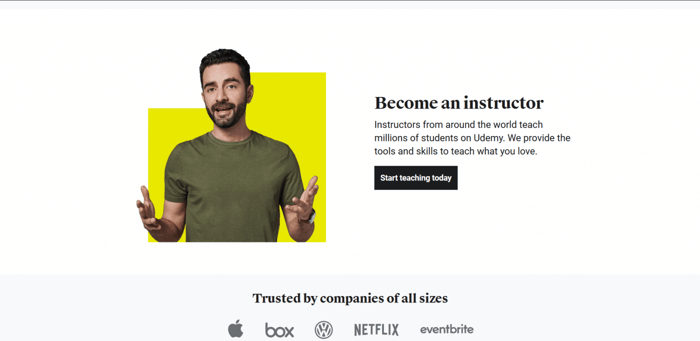
What this implies is that you can sell and promote your courses on other platforms and vice versa. So, if you’ve already created and published courses elsewhere, you can upload them to Udemy as well.
As long as you respect Udemy’s policy and avoid publishing courses on subjects found on the restricted topics list, Udemy won’t stand in the way between you and your prospective students.
What Are the Downsides of Udemy?
1. Not Suitable for Building a Brand
The Shortcomings of Online Marketplaces
Since Udemy is a huge marketplace, you, as an instructor, as well as your courses, can become virtually invisible in the sea of other instructors and courses. This is not unique to Udemy – it’s a general shortcoming of online marketplaces. You’re starting from the same place as all your competitors.
For example, when someone’s looking for a Python course, they see your Python course along with many other instructors’ Python courses side by side. Or it might happen that they don’t even see your course if you haven’t been receiving the best customer reviews.
Scarcity of Possibilities
As we’ll see shortly, the fact that Udemy offers only a handful of design options also doesn’t help much in the context of brand building. If you’ve ever been on the Udemy site, all courses look similar. If you’ve seen one, you’ve seen them all. Udemy doesn’t provide you with even the most elementary tools to build a strong, recognizable brand.
However, that’s not to say that there aren’t very popular and successful Udemy instructors who’ve managed to create a large community of loyal students thanks to their excellent teaching skills and high-quality courses.
That said, not many of us see their Udemy endeavors as separate businesses. They are more like good merchants with great products who own a stall on a large market rather than business owners who have managed to build a distinguished brand.
2. Revenue Share Model and Other Downsides
Revenue Share Model Overview
Registering on Udemy and publishing courses at no cost doesn’t mean that this platform is completely free. Udemy is not a non-profit, so there has to be a way for it to make money. One of the ways is through the revenue share model. It means that the company takes a certain percentage of any sale in return for the heavy lifting it does for you in terms of hosting and promotion.
Udemy takes a massive 63% of your earnings every time you sell a course if the purchase is made with no promotional efforts on your side. Say, a user sees a Udemy ad somewhere on the internet, clicks the ad, goes to the Udemy website, and buys your course. The actual money you earn is 37% of your course price.
You can earn more if you promote your courses yourself, which is possible. Udemy lets you use coupons and referral links, and when a purchase is made in this way, your cut is 97%.
Additional Fees
In addition to this, you’ll have to factor in the other fees that you pay. There are additional transaction taxes, mobile platform fees (for purchases on iOS and Android devices), and service and processing fees to consider. These, together with the usual Udemy revenue share, can significantly reduce your profits.
Discounts
Udemy has the right to sell your courses at extremely discounted prices. Say, the original price is $89.99. The platform can promote your course at the price of $13.99. Of course, there is a cap, and the discounted price can’t go lower than $9.99, but this is hardly music to instructors’ ears.
So, selling on Udemy assumes selling at prices lower than what you’d like. Anyone who’s ever visited the platform can attest that there are always some big discounts to attract more users and increase sales.
Price-Tier Model
Unlike Teachable, Udemy has a price-tier model that doesn’t allow you to sell courses at a price higher than $199.99. This is the full list of possible Udemy course prices:
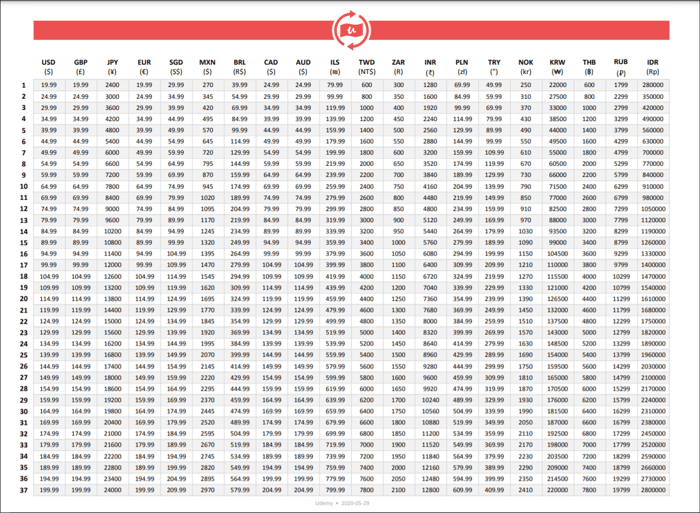
A price cap together with a price-tier model like this limits control over your revenue and is far from ideal for course creators who like having more sway over their business.
3. Lack of Design, Customization, and Control Options
It’s not that Udemy completely lacks design, customization, and control options – it’s more that what it offers is very bare-bones.
Audience and Course Structure
When you start creating your course, Udemy allows you to clearly define who the intended audience is and what the prerequisites are (if there are any) for students taking your course.
After this, it gives you tips on how to structure your course content. In case you need some more in-depth advice, you can head over to the Udemy Teaching Center and check out the articles there.
Videos
The tips on course structure are followed by a video equipment check. Then, you can start the process of adding course content.
You have three options regarding the type of content: video, video and slide mashup, and article. The minimum requirement for video quality is 720p, and your video can’t exceed 4 GB. You can also add captions if you want to make things even easier for your potential students.
Landing Page
Udemy allows you to create a landing page for your course. You can add:
- A course image (jpg, jpeg, gif, or png) and promotional video, a subtitle, and a description.
- Student level: beginners, intermediates, experts, or students of all levels.
- A category: music, photography, programming, or martial arts, for example.
- A biography.
- Referral links or coupons for paid courses (you can also offer free courses on Udemy).
- Welcome and congratulations messages.
Of course, you can’t sell everything on Udemy. There are certain criteria that your course needs to meet, so before you publish it, the Udemy team reviews your course to establish whether it satisfies the company’s policy and standards.
Conclusions
The absence of real editing options, customization possibilities, or more advanced features (like email marketing and automation tools) – together with the pricing limitations – leaves Udemy looking very basic. You’ll certainly notice the difference when we start delving into some of Teachable’s features.
However, keep in mind that everything in the business context comes with a cost and a trade-off. In the context of Udemy, the lack of design, customization, and control options is a trade-off for simplicity. Therefore, if the simplicity works for you, you’re gonna love Udemy.
However, if you’d prefer to build your own brand and have greater control over your e-learning venture – Udemy is likely not a good fit.
Why Is Teachable Good?
1. Various Features, Customization, and Extensibility Options
The degree of customization and extensibility you have is probably the biggest advantage that Teachable has over Udemy.
This is obvious even if you just glance over the dashboard of the two platforms. This is a part of the Teachable admin dashboard:
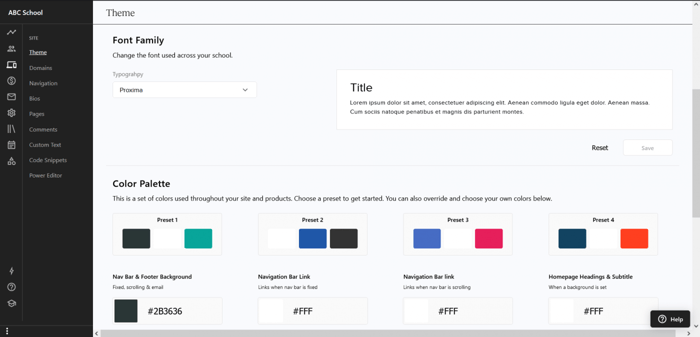
And this is what you see when you choose to edit your course’s landing page in the Udemy admin dashboard:
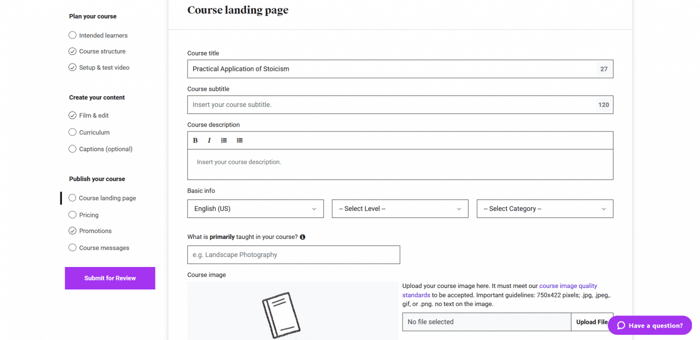
Teachable lets you do so many things:
- Choose from three design templates (Classic, Simple, and Colossal).
- Edit your current theme (change colors and fonts, as well as add logos, thumbnails, and favicons).
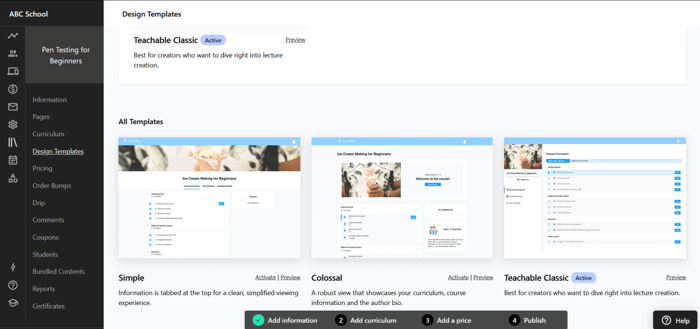
- Use a custom domain name.
- Add multiple pages.
- Use a template editor to create different types of emails.
- Assign custom user roles, and so much more.
Teachable also enables you to use code for design purposes and adding more functionality to your Teachable course site. For example, you can use code snippets to make global changes to your site.
You can also use the Power Editor (only with the Business plan) to add custom HTML, CSS, and Liquid code. On top of this, Teachable allows you to add HTML embed code to extend your Teachable course site with functionalities that the platform doesn’t offer.
Let’s say you want to add a blog, knowing the important role it can play in marketing and brand-building. Teachable doesn’t offer a native blogging option, but there’s a solution: you can integrate DropInBlog into Teachable. It’s a very quick and simple process using the embed code method, all detailed in our article on How to Create a Blog on Teachable.
In addition to this, you can add third-party software and extend your course site in a more direct way through your admin dashboard. Presently, Teachable officially offers the following integrations:
There’s even more to Teachable in terms of choice and possibilities, but we think this was sufficient to show you the array of options that Teachable offers in comparison to Udemy.
2. Build Your Own Brand
Crucially, Teachable is an LMS (Learning Management System) – not a course marketplace like Udemy. Everything you do on Teachable, you do independently of the other Teachable online schools and course creators.
On Teachable, you build your own standalone online school where you can offer as many courses as you like and build a student community that’s entirely your own. You don’t share the same space with your competition, and thanks to all the sales and marketing features that Teachable offers, you can build your own recognizable and distinctive brand in the online education realm.
On top of this, in contrast to Udemy, you can remove the Teachable branding from your course site (starting with the Pro plan). This is a clear indicator that a platform is committed to letting you develop your own brand.
3. Affiliate Program
An affiliate program is an excellent way to promote your online school, courses, and brand without lifting a finger. It works by letting other users advertise your courses and school. In return, every time you sell a course through their promotional efforts, they get a percentage of the purchase. It’s a win-win situation for everyone involved.
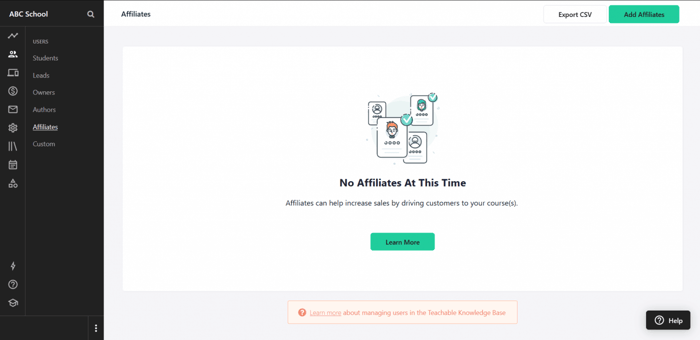
Keep in mind that this feature is not available with all pricing plans – you need to have at least a subscription to the Pro plan to enjoy the perks of an affiliate program.
What Are the Downsides of Teachable?
1. Upfront Costs
Teachable is different from Udemy in regard to upfront costs. It has a pricing system that consists of different pricing plans, and you get access to different features depending on the pricing plan you choose.
Teachable offers three paid plans and two types of subscriptions: monthly and annual. The following are the fees for the paid plans:
- The Basic plan: $59/month (paid monthly) or $39/month (paid annually)
- The Pro plan: $159/month (monthly) or $119/month (annually)
- The Business plan: $665/month (monthly) or $499/month (annually)
Of course, choosing an annual subscription means you pay in advance for the whole year, which means you’ll have to pay $468 for the Basic plan, $1,428 for the Pro plan, and $5,988 for the Business plan.
In addition, you’ll also pay standard processing fees to the payment service provider, but this is not specific to Teachable. By choosing to sell goods online, regardless of which platform you use, you’ll have to pay processing fees.
On top of the regular monthly/annual fee and the processing fees, if you subscribe to the Basic plan, you have to pay a 5% transaction fee as well. This means that Teachable will take 5% of your profits every time you sell a course.
Clearly, these costs can add up and severely affect your revenue. The costs of running an education business on Teachable and similar platforms can be one of the reasons why users choose platforms like Udemy. They provide the means to start selling in no time with virtually no upfront costs. Despite all the disadvantages of Udemy’s revenue share model, the low-cost option can be very appealing.
However, the good news is that Teachable offers a free plan that’s perfectly suitable for starting a very legitimate online school. With features like free hosting, unlimited students and courses, instant payouts, and even third-party integrations, this plan is a good way to start your journey in the online education niche.
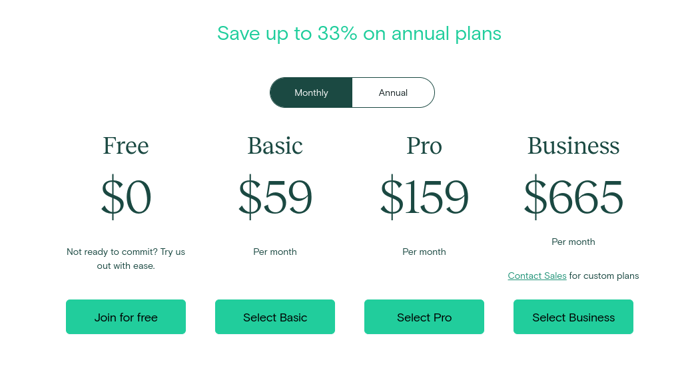
Of course, as is always the case with this type of plan, there are drawbacks. The $1 plus 10% transaction fee, an inability to use a custom domain, and the lack of serious marketing tools are just some of them.
But, despite its drawbacks, the Free plan is a viable alternative to Udemy, so it should be taken into account when comparing the two.
2. Start from Scratch and Promote Yourself
Another potentially serious issue when running an online school on Teachable is the process of building your audience from scratch. While Teachable offers plenty of tools that put you in a good starting position when it comes to marketing, it’s not as simple as it may look.
The risk is not being able to attract an audience at all, let alone build a loyal customer base, even after months. It can be especially difficult for inexperienced users. Sometimes, this process takes a lot of time, money, blogging, research, patience, persistence, trial and error, and maybe some experts’ help to get where you want your education business to be.
On the other hand, if you like challenges and enjoy the satisfaction that comes from building your business all by yourself, then starting from the ground up will give you that.
3. Not as Simple to Use as Udemy
Frankly, compared to other LMSs, Teachable is not that difficult to use. However, compared to Udemy, it’s much more time-consuming to build, set up, and manage. You don’t need to be an expert, but you’ll need to do your research, and there will be an amount of effort involved.
Running an online school on Teachable will certainly require at least some basic technical knowledge and understanding, as opposed to just creating and selling courses on Udemy. This effort can be a deterrent for those that just want to focus on their educational content.
FAQs
Can you put the same course on Teachable and Udemy?
Technically, yes. Udemy doesn’t penalize instructors for placing their courses on multiple platforms. You can build your own e-learning brand and post courses on Udemy for good measure if you really want to.
Which takes a higher cut from my sales, Teachable or Udemy?
Udemy takes a notably large cut from each sale, but don’t forget that on Teachable, you’ll be paying a subscription cost and transaction fees. In any case, Udemy is likely to take a higher cut overall from your revenue.
Is Teachable more customizable than Udemy?
Absolutely. The focus of Udemy is not to build an eye-catching website or landing page but to simply host your courses. On the flip side, Teachable gives you the uninhibited ability to build your website, market your brand, and host whatever style of educational content you want.
Final Thoughts
In this simple Teachable vs. Udemy comparison, we had a look at some of the pros and cons of these two course hosting platforms. By now, it’s become very clear that they represent two contrasting models of course hosting.
Teachable is focused on enabling you to create your own standalone online school and provides you with a plethora of tools to do that while building your own brand. Udemy is a massive marketplace that concentrates on simplicity, where the majority of the heavy lifting is done by the platform itself, not the course creators. While Teachable charges different fees for its services, Udemy makes use of the revenue share model.
Which platform do you find more appealing? Even more importantly, which one is more in line with your expectations and needs? Hopefully, this article helped you toward making an informed decision and will settle on the right platform to host your courses.


